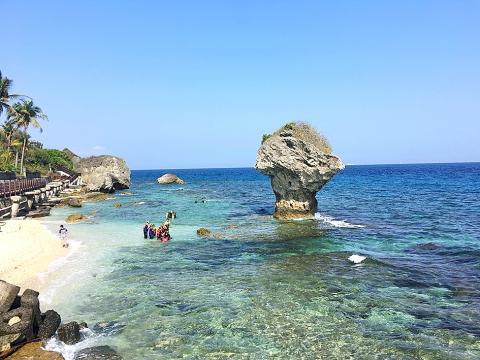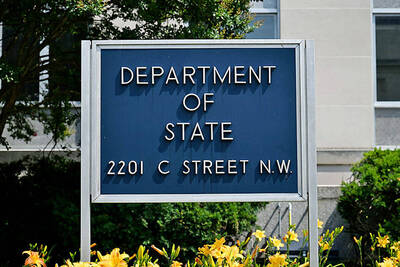The Tourism Bureau is assessing the feasibility of capping the number of people allowed to visit Orchid Island (Lanyu, 蘭嶼), Green Island (綠島) and Siaoliouciou Island (小琉球), Director-General Chou Yung-hui (周永暉) said.
“Between ecological conservation and tourism, society has gradually adopted the concept of a tourism cap,” Chou said, adding that the bureau hopes to find a balance between tourism development and the quality of tourism.
As people become more environmentally conscious, an increasing number of popular travel destinations have seen local residents call for limits on the number of tourists in their areas.

Photo: Hsiao Yu-hsin, Taipei Times
On Orchid Island, where tourism — and consequently the amount of trash — surges during the summer, residents first proposed capping the number of visitors two to three years ago.
Siaoliouciou Island, which had more than 1 million visitors last year and has seen its intertidal zone damaged, is scheduled to host a panel for local residents this month to discuss a tourism cap.
Turtle Island (Gueishan Island, 龜山島), Yehliu Geopark (野柳地質公園) in New Taipei City, and Kinmen County’s Dadan Island (大膽島) and Lieyu Township (烈嶼) have already adopted such caps, Chou said.
The bureau is now considering other areas and will discuss caps on islands with the public at the Modern Tourism Forum, he said.
During its peak tourism season last year, Siaoliouciou Island broke its daily water usage record of 6,000 tonnes, while surges in electricity usage led to a power outage on parts of the island, said Chen Wen-yu (陳文玉), the director of a tourism association on the island.
There should be a cap on the number of tourists and visitor activities should also be spread out instead of concentrating in the intertidal zone, Chen said.
Introducing a cap for Siaoliouciou could lead to protests because not many people visit the island on weekdays and tourism is largely concentrated on weekends or holidays, Liouciou Fishermen’s Association chief executive Tsai Pao-hsing (蔡寶興) said.
Now that Siaoliouciou Island has become a prime tourist attraction, the government should reassess its plans for land use and reduce the amount of farmland on the island, he added.
Lanyu Township Representative Council Chairman Chang chin-shang (張錦商) said he backs the idea of a cap, but also believes there should be supplementary measures and communication between the tourism industry and local representatives.
Many visitors to Orchid Island generate large of amounts of trash and disturb the environment, and the island cannot sustain such practices, he said.
Some day-trippers use the public restrooms, leave their trash and depart without spending any money on the island, he said, adding that if a cap is introduced, he hopes it would promote two-night stays on the island.
Lyudao Township Representative Council Chairman Ho Fu-hsiang (何富祥) said the number of visitors to Green Island has dramatically increased in the past three to five years.
If a cap is introduced in the summer, the peak tourism season, and no one visits in the winter, the policy would be criticized by island residents, he said.
The bureau should disclose its basis for evaluating the feasibility of a cap and protect legal hotels and guest houses instead of allowing the continued construction of illegal guest houses, he said.
The bureau has also tried to curb overcrowding by encouraging people to visit popular areas at different times throughout the day, Chou said.
For example, last month it allowed nighttime visits to Yehliu Geopark’s “Queen’s Head” (女王頭) for the first time, he said.
Additional reporting by Yeh Yung-chien

MISINFORMATION: The generated content tends to adopt China’s official stance, such as ‘Taiwan is currently governed by the Chinese central government,’ the NSB said Five China-developed artificial intelligence (AI) language models exhibit cybersecurity risks and content biases, an inspection conducted by the National Security Bureau (NSB) showed. The five AI tools are: DeepSeek, Doubao (豆包), Yiyan (文心一言), Tongyi (通義千問) and Yuanbao (騰訊元寶), the bureau said, advising people to remain vigilant to protect personal data privacy and corporate business secrets. The NSB said it, in accordance with the National Intelligence Services Act (國家情報工作法), has reviewed international cybersecurity reports and intelligence, and coordinated with the Ministry of Justice Investigation Bureau and the National Police Agency’s Criminal Investigation Bureau to conduct an inspection of China-made AI language

BOOST IN CONFIDENCE: The sale sends a clear message of support for Taiwan and dispels rumors that US President Donald Trump ‘sold out’ the nation, an expert said The US government on Thursday announced a possible sale to Taiwan of fighter jet parts, which was estimated to cost about US$330 million, in a move that an expert said “sends a clear message of support for Taiwan” amid fears that Washington might be wavering in its attitude toward Taipei. It was the first announcement of an arms sale to Taiwan since US President Donald Trump returned to the White House earlier this year. The proposed package includes non-standard components, spare and repair parts, consumables and accessories, as well repair and return support for the F-16, C-130 and Indigenous Defense Fighter aircraft,

CHECKING BOUNDARIES: China wants to disrupt solidarity among democracies and test their red lines, but it is instead pushing nations to become more united, an expert said The US Department of State on Friday expressed deep concern over a Chinese public security agency’s investigation into Legislator Puma Shen (沈伯洋) for “secession.” “China’s actions threaten free speech and erode norms that have underpinned the cross-strait ‘status quo’ for decades,” a US Department of State spokesperson said. The Chongqing Municipal Public Security Bureau late last month listed Shen as “wanted” and launched an investigation into alleged “secession-related” criminal activities, including his founding of the Kuma Academy, a civil defense organization that prepares people for an invasion by China. The spokesperson said that the US was “deeply concerned” about the bureau investigating Shen

LIMITS: While China increases military pressure on Taiwan and expands its use of cognitive warfare, it is unwilling to target tech supply chains, the report said US and Taiwan military officials have warned that the Chinese People’s Liberation Army (PLA) could implement a blockade within “a matter of hours” and need only “minimal conversion time” prior to an attack on Taiwan, a report released on Tuesday by the US Senate’s China Economic and Security Review Commission said. “While there is no indication that China is planning an imminent attack, the United States and its allies and partners can no longer assume that a Taiwan contingency is a distant possibility for which they would have ample time to prepare,” it said. The commission made the comments in its annual